FIELD: Drawing as Experience: Introduction to Key Ideas and Lecture
Posted: January 21, 2015 Filed under: Drawing as Experience, FIELD | Tags: art student, craft in the bay, create, drawing, drawing as experience, drawing experience, drawing with nature, emotion, emotion art, experience, experiences from art, experiences of the world, field, fineart, lecture, sense, senses, sensory art, sensory object, synaesthesia, the sensory object, world Leave a commentWithin this field module, I will be introduced to a diverse number of approaches to drawing experiences. It will focus around three key elements: Drawing, Creative Strategies and ways in which ideas develop. The location of this first introductory session, was Craft in the Bay, Situated in Cardiff Bay.
Why Craft in the Bay?
We are working in Craft in the Bay because of the interest and links a current exhibition called “The Sensory Object” has with Drawing experience. Sensorial Objects are similar to drawing experience in that they both arise the questions: How can we sensate the world? How can we crystallize a sensation in an artwork? They deal with the language of expression and the translation from inanimate object to the emotional/sensorial realm.
Perception is active. Active engagement with artwork is key to people becoming emotionally and sensorially engaged with your work. If you want them to feel something, you need to think about how they engage with the art.
The Sensory Object: Drawing Experience
Sensory connects with emotionally. Emotions and senses are housed in the same place. For example, you see something soft and you feel comfort. From browsing this exhibition and undertaking this field option I should learn different ways of capturing sensory and emotional values in artworks and drawings and explore what to do with that knowledge.
Synaesthesia – A fusion of the Senses
Merlau Ponty explores relevant themes in his 1962 book – “The phenomenology of Perception”. It highlights your bodily presence in the world and how you experience the world around you. For example, you do not understand texture by looking at it, only when you touch it do you fully comprehend it.
Jac Saorsa 2014 – Drawing Women’s Cancer
Jac Saorsa uses the vocabulary of drawing to speak to people about their illnesses, in a human way. She helps people understand what is happening to them and encourages them and supports them through it through her art. “In this space, Practice itself becomes the voice of suffering”. The work is visually successful in my opinion, but also houses a deeper purpose and a powerful aid to sufferers. It is incredibly interesting to think about how pieces of art heighten certain senses or speak to people or help them through things. Expression in drawing can be very powerful. Fragility in quality of line etc echoes dealing with a sense of life.
Harry Ally – Painting and Process
Harry Ally’s work contains an incompleteness that suggests rather than illustrates. Suggestion brings context and meaning. I am very inspired by this work and I feel that it allows the viewer to delve into their imagination and visualise the suggested in their own way. This work contains physical depth in the layering of materials on top of one another which can relate to emotional depth.
What can be felt through quality of Line?
What can a drawn mark do? Can it Scar or cut? Time is embedded within it. Can drawing enable us to explore experiences? Can our drawing enable others to explore experience?
Drawing can take someone on a journey, through a connection from Line to sensation to emotion. Drawing can be used as a tool that can heighten your experience of the world as a means to explore and examine. It can also be used to heighten the experience of others. Children perceive the world without thinking about it, children are curious, all senses are live.
The Ideas of John Berger 2002
John Berger maintains that you can make beautiful drawings, that speak of virtuosity and ability. The act of drawing and process can get you to look at things with such focus and consideration that it allows your mind to think differently about it. The drawing can speak to you, you impose certain values on that piece of paper. When drawing observationally, another reality could arise from it – imagination. Drawing can allow fictitious themes to slip in. Drawing can slow things down.
Why do we draw? Why do we create?
We create things that weren’t there before, but link in to the inspirations and experiences of the world.
I can already see how this option will be beneficial to my practice and current subject work. I want to portray my own experience of my local landscape and a connection to the place but I also want others to gain experience from it and feel a connection to the landscape and the natural objects within it. I feel like this option will encourage me to consider how the marks made and materials used can evoke emotional and sensory experiences. I also think it will open my eyes to linking my work to place and experience in a wider variety of ways. It is important that my work could send someone on a journey or encourage thinking and I am looking forward to putting this into practice through drawing and applying what I learn into my artistic practice and subject work.
ROMANTIC LANDSCAPES: A lecture by Jon Clarkson
Posted: November 13, 2014 Filed under: SUBJECT, Subject - Contextualisation | Tags: anselm kiefer, art, art lecture, art research, art student, artists, artists research, caspar david friedrich, francis darby, jan van goyen, landscape art, Landscape painting, lecture, maria neudecker, mark rothko, Richard Wilson, romantic landscape, romantic landscape painting Leave a commentWhat is my place in the world?
Do I belong there?
Caspar David Friedrich – Monk by the Sea
Comparing it to a classical Landscape – Richard Wilson, The White Monk 1760-65
Caspar David Friedrich – Morning in the Sudeten Mountains 1810-11
How does Friedrich’s painting differ from wilsons? Colour palette, mood.
How do the painters think about religion?
Wilson seems more distant from religion than Friedrich. Friedrich is thinking of religion organising our relationship with the natural world.
In Caspar David Friedrich – Monk by the Sea – What time of day is it?
Written about as a lightless dawn. For the monk, the dawn isn’t important as it is for the pair on the mountain in the other piece.
Do you think that this place is real or imaginary?
It is a culmination of experience . Long flat horizon. Empty paintings.
Jan Van Goyen – View of Harlem 1646
Alternating pattern of light and dark, Colours lighter in the distance, more full of colour in the foreground. There is more cloud perspective than in friedrichs work. Friedrich’s is much flatter. Distance becomes flatter and more immense because there are no markers in it.
Mark Rothko 1969 – Is there still distance in this picture? Does it look like a place to you? There are similarities to Friedrich’s work. It is stark and there is a fluctuation between flatness and deep space.
There is a lot of fine detail in Friedrich’s Monk by the sea. It makes it look more like a portrait of the place. When you notice a painting has fine detail, you walk in closer to it. Having an intimate relationship with the work. The artist must be thinking about where he wants the spectator to be. The monk isn’t entirely resolved in himself.
What is the relationship between these figures and their surroundings?
Caspar David Friedrich – The wanderer above the sea of mist
The figure is taking possession of a view, dominating the landscape. He wants to be there and he is in control.
The Chasseur in the Forest 1814
The landscape is dominating the figure here, he has no horse, he is lost and not in control. He’s french, the forest is german. Friedrich is a nationalist. German land rising up against the french invaders. Vulnerable.
Francis Danby – Romantic Woodland landscape 1824-5
Will nature accept us? Romantics think of nature in a more psychological way than an ecological way.
Anselm Kiefer, Varus 1976 – For Kiefer, Germany begins with Slaughter in the forest.
Marina Neudecker – Things can change in a day 2009
Models in vitrines suspended in liquid. Does the vitrine intensify the situation or distance you from it? Like a cinema screen, they encourage you to project yourself into the scene.
How does a group rather than a solitary figure alter the confrontation with nature?
Caspar David Friedrich – Chalk Cliffs at Rugen 1818 – less vulnerable, more people – However, not a strong sense of communication.
CLASSICAL LANDSCAPE: A Lecture by Jon Clarkson
Posted: November 9, 2014 Filed under: SUBJECT, Subject - Contextualisation | Tags: art, art lecture, art student, artist, artists research, charles sheeler, classic art, classical landscape, contextualisation, george shaw, gregory crewdsen, landscape, Landscape painting, lecture, Nicolas Poussin Leave a commentIs the Visible World enough?
Classical Landscape is a name given to a type of painting – developed in the 17th century. Related to History Painting. Some have narratives and some don’t. Mood and atmosphere is conveyed within the paintings
Is the artists job simply to record the appearance of the world, or to transform it?
Nicolas Poussin – Landscape with a Calm 1650-1. Based in Rome. Peaceful/neutral. More movement in the sky, contrasted with a static lake and a still and calm foreground. The people are small and insignificant in comparison to nature. A vision of an ordered, harmonious society.
Nicolas Poussin – Landscape with St.John on Patmas 1640
Is the relation betweeen humans and nature the same as in the Landscape with a calm? How is history represented?
It is more like land left behind. Have humans taken advantage? Have they moved on? Even though, John is sitting, he is not really entwined into the work like the people in the other piece.
Nicolas Poussin – Landscape with the body of Phocion – carried out of Athens 1648. This has a narrative. Alternatiing bands of dark and light. Neverending path it seems. The city is close enough to be important in the painting, but far enough away that we stop being able to see how we could get there. There is a complicated visual access to the city
Nicolas Poussin – A Roman road. An announcement of technological Power. Political, This kind of depth, perspective is highly technologically advanced for the 17th Century
Charles Sheeler – Classic Landscape 1931
Where is the nature in this Landscape?
It has gone, However: there is natural organisation in the pile of earth and sand
Charles Sheerler – American Landscape 1930
Is he being ironic calling this a landscape? Even though there is no nature within the picture, it is a man-made landscape. Does he want us to find these scenes beautiful or ugly? Brighter lighting, reflections, some bright colours, making it look more appealing but very geometric.
George Shaw – Scenes from a Passion: 2002: Paints areas where he grew up. A question is posed about the conventions we use to describe reality
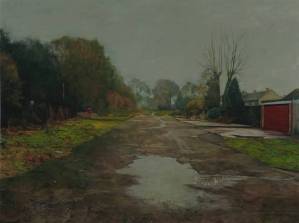
George Shaw – The blocked Drain – 2010
(not a version of Poussins roman road) but does our knowledge of it affect how we view this?
The first road seems new and innovative. George Shaws seems barren and disregarded.
Gregory Crewdsen, The madison 2007
Takes still photos, but like a hollywood movie. The road is always the same road continuing. Imagining the thoughts of the landscape from the figures perspective.
Gregory Crewdsen, untitled (Beneath the roses) 2007
What is the relation between nature and culture here?
Organic elements separate from man made, degraded nature. The nature is not lush greenery, it is weeds. Could be hopeful after destruction, is nature reclaiming it?
Gregory Crewdsen – Beneath the roses 2006
Beneath the surface, looking deeper, a metaphor?
Relationship between the two people – could they be lovers? Could be an attacker and she is a victim. Soothing or disturbing? Degraded nature again and disturbing elements.
Nicolas Poussin – Echo and harcissus 1630
Eduardo Manet – Le dejuner sur (l’herbe 1863)
Do these paintings change the way that we look at Crewdsen’s photographs? In what way?
Art in Context: Working Away – A lecture by Sue Hunt
Posted: October 31, 2014 Filed under: SUBJECT, Subject - Contextualisation | Tags: art, art based projects, art travel, artist, charity art, community art, lecture, mothers of africa, murals, sue hunt, working away, workshops, zambia Leave a commentAn exploration of working as an artist in an international community context
Mothers of Africa is a Charity Organisation that aims to lower the amount of Mothers dying in Child birth and the amount of babies losing their lives in Africa. Sue Hunt went out to Zambia to create artwork with a community that supported the work of the charity organisation. She went to explore ways of making visual work with local artists and villagers, maybe giving them a voice, empowering them and helping them to express their needs visually.
Within this Lecture, we were shown images of what resources in Zambia are like. We thought about how community artwork can be hampered by social context. For example, they has no art materials and had to source them for projects. Art can be used in this sense to bring communities together and get people conversing that usually would not interact with one another.
Art was not often taught in schools in Zambia and so it was welcomed with open arms. Sue Hunt and a team of people ran workshops for the Zambian adults and children like Cyanotype, photography projects and they all made murals together. Works were then framed and displayed in the hospital where the mothers of africa charity comes into play. They were there for all to view, to lift spirits and make the bear walls more appealing. They also got villagers to write down messages of what was wanted and needed within the village and hospital to produce work from.
This lecture was a prime example of the role of the artist bringing communities together achieveing the lifting of spirits and encouraging change. This has inspired me to think about how I could maybe work with communities in the future and work on art based projects.
IS THE HUMAN BODY A MATERIAL OBJECT OR A SPIRITUAL BEING? – Lecture by Jon Clarkson
Posted: October 13, 2014 Filed under: SUBJECT, Subject - Contextualisation | Tags: Anthony McCall, art, art student, artist, body, Caravaggio, fineart, John Coplan, jon clarkson, lecture, Lecture Notes, light, material, spiritual Leave a commentJon Clarkson delivers his lectures through questions and both him and the participating students work together to answer them. This is an effective way of teaching as it encourages you to think about the piece of artwork for yourself. Caravaggio’s work and the work of John Coplans and Anthony Mcall is being used as a visual resource to help us ask the question: Is the Human body a material object or a spiritual being?
Caravaggio – John the Baptist, 1602
How old is the subject in the painting by Caravaggio? In this painting, the face portrays a different sort of age to the body. At one level he is prepubescent, there is no hair on the body in adult areas like the chest or intimate region. However, the arm of the body is manly, strong and muscular so there are contradicting signs of ages combined into one body in this piece.
Is it shocking to see him portrayed this way? There is something quite shocking about this piece. It has a kind of erotic content. This is evident in the position that he is laying in. It is also evident in the intimate relationship that seems to be going on between him and the sheep, it is nothing the relationship that a typical shepherd would have with a sheep. There are also silks and furs around the sensitive area.
Do you think that this is a voyeuristic image? We are invited to think about how the body touched the world and how the world touches the body. Voyeuristic is the idea of peeping through a keyhole. This image is not voyeuristic. It is like the subject is posing for the viewer and is aware of the observer. We were asked to think about whether the eroticism of the image undermines its religious purpose and to me it does, but to other students in the room, they felt that the religious element over shone the eroticism.
Caravaggio – The Calling of St.Matthew
Is the light real/realistic? Light is the primary subject but it is not really very realistic. There are many different directions of light. It has been said that he “He painted in a cellar with a single light”.
Is it inside or outside? It is thought that this painting is supposed to be outside in an alleyway in the early evening. There are two different eras going on in the image and the light in the work is both spiritual and material.
The hand of Jesus that can be seen within this work has been used before. It has been copied/appropriated from a Michelangelo piece on the ceiling of the Sistine Chapel 1508-12. Jesus looks tired and the hand is doubled in the painting by peter’s hand. Is it just a clever reference or does it affect the way we understand the painting. There are not enough legs on the table in this piece and is there enough room for everyone? The space available has been compressed.
Caravaggio – Conversation of St.Paul 1601
Who see’s what? The Horse sees Paul. The man sees the horse. Paul see’s Jesus but we as the observer don’t.
This image is supposed to be set at mid day so what is the light? Spiritual light/enlightenment. There are contradictory special markers within the piece.
This piece can be paired with Caravaggio’s piece – Crucifixion of St. Peter 1601. There are two great bottoms prominent in the picture, the bum of the horse and the bum of a man.
This painting seems to be of the point where St. Peter realises that he is being crucified. His face seems to convey shock and surprise, it is now becoming real.
How are the executioners depicted? Peter is the only real character here. There are no visible faces on the other people in the painting. They are 17th Century peasants and they don’t fit in. Making something contemporary in order to make it real.
John Coplans – Hands Holding Feet 1985
Within this piece, The sense of the body as a whole has completely disappeared. There is a focus on light and it looks like the legs are missing. Feet can still give offence.
John Coplans – Self Portrait, Interlocking Fingers 2000
With John Coplans work you never get the whole picture, but with Caravaggio you do. Is this piece erotic in anyway? Is it possible to compare it with Caravaggio’s depiction of the human body.
Unfortunately Jon Clarkson ran out of time to finish this lecture, which is such a shame because his analysis of these works in relation to light and the body was incredibly interesting. He ended the lecture by making us aware of the work of Anthony McCall.
WHAT IS THE RELATION OF CONTEMPORARY ART TO THE ART OF PAST? – Lecture by Jon Clarkson
Posted: October 10, 2014 Filed under: SUBJECT, Subject - Contextualisation | Tags: art, art student, artist, citizen kane, eugene delacroix, gaugin, lecture, painting, photography, tom hunter Leave a commentDoes every picture tell a story? Does every picture have a relationship with a set of ideas or words?
Paul Gaugin – Where do we come from? What are we? Where are we going? 1897-8
Paul Gaugin made the painting and then the title came after, he is reflecting on it and the questions become in a sense – the answer.
Pierre Puvis de Chavannes, Inter Atres et Naturam 1890
There are common elements in both paintings: picking the apple, curiosity, fruit and experience. They have a common theme of fruit and nature giving into art and culture.
Eugene Delacroix – The Death of Sardanapalus 1827
Does this painting have an underlying message or moral? Which is most important, story or spectacle? In response to this piece, Tom hunter produced the photography work – Death of Coltelli 2010
There is a documentary quality to the room, he has added a fictional element in including the woman. She is figure of grief and portrays the significance of human life.
The Destroyed Room 1978 by Jeff Wall is a fictional set. If the room is set up, does it matter? who lived there or who destroyed it? If it doesn’t matter then why did Jeff Wall select these objects? In the lecture this was compared to Citizen Kane – Room Trashing Scene. Where the man’s wife has left and he is destroying all their stuff but he is still not control.
ART IN CONTEXT: Cut and Paste – Tearing through Collage: Lecture by James Green
Posted: October 10, 2014 Filed under: SUBJECT, Subject - Contextualisation | Tags: architectural collage, art, art student, art theory, artincontext, artist, artists, assemblage, collage, composition, decollage, fineart, george braque, grayson perry, hannah hoch, inspired, james green, jennifer taylor, joan miro, Kurt Schwitters, lecture, max ernst, memory jugs, mimo rotella, peter blake, picasso, raoul hausmann, sculptural collage, sculpture Leave a commentCollage is the noun from the French ‘Coller’ – Literally “to glue” or “to stick.
There was a lot of imagery and variety of artists work shown to us in this lecture, it was a lot to take in but during the lecture you really felt captured and immersed into the world of collage. When the person giving the lecture is highly animated about the subject that they are talking about it definitely keeps your interest and James is definitely a collage enthusiast.
It started being used as a serious art form about 100 years ago in the form of Victorian layered collages and collage style screens.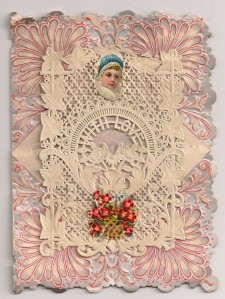
In the 1900s – Printmaking techniques were created which enabled an easier production of posters etc. There were no Laws prohibiting people sticking up adverts onto buildings and so buildings in Paris got fly posted like giant collages.
Picasso created one of the first fine art collages in history. Picasso worked with George Braque. Cubism – Collages of different view points being stuck together in a painting. This is evident in Picasso’s, The Accordionist and Braque’s, Le Portugais.
Braque and Picasso were both influenced by collages on the streets. They were being introduced to text and so Letters became introduced in their paintings. They used whatever materials that they could get their hands on as they were poor. They moved form painting to cutting out wallpaper and newspaper and drawing onto it etc. Below is an image of “installation of Papier’s Colles in Picasso’s studio 1912”.
Both Picasso and Braque created still life work with collage elements within them. Picasso’s, Still life with chair caning 1912 is an oil on canvas with a rope around it. It represents a glass table top and combines collage with painting. Braque’s still life on a table 1914 is more tactile and incorporates more materials.
Kurt Schwitters forms in space 1920 is a collage piece. He called his work “merz” which basically means shit. He used bits of rubbish, sweet wrappers/string and to him these materials all had equal right with paint. Schwitters has also made architectural collages and in his original merzbau in his Hanover studio 1923 – he creates and makes a room into a collage piece.
Herbert Read – “Schwitters is the supreme master of collage”.
Another artist that created rooms of a kind of collage is Jennifer Taylor. In her piece, Junk Painted White, she has filled a room with collected artefacts that she has hoarded over the years and painted white.
Hannah Hoch and Raoul Hausmann created Dadaism to reflect the irrational and crazy world around them during the war time. Tatlin at home 1920 collage. Mechanical Head 1919. Here found objects are almost mounted onto a wooden head. This is where a sculptural element becomes added into collage. Surrealism, Cubism and Dadaism were all happening at the same time and all of these movements incorporated collage. Max Ernst created irrational stories through collage. His collages look like they are printed, there are no joins or evidence of different components being stuck together.
Joan Miro – painting 1933. He would collect Victorian catalogues and cut out things, drop them into the floor onto paper and wherever they landed he would stick them . He used collage to make up the composition of the painting that he would do. Joseph Cornell 1903 – 1972 created boxes containing collage that are like a gateway into his mind.
DECOLLAGE – Mimo Rotella un poco in su 1954 – Instead of sticking things on this artist would rip them off which became known as decollage.
Peter Blake is an artist that very much seemed to be favoured by the lecturer. He was particularly interested in the varied elements and collaged areas in his piece Kamikaze. There are many different processes in this piece. Cryla and collage on board, elements stuck on the outside on the piece, combining painting with collage and sculptural or 3D collage. Peter Blake also painted paintings that were made to look like collage but actually contained no collage at all.
Collage – any collection of unrelated things
Eduardo Paolozzi Bunk 1972. Pop Artist that uses collage. From creating collages, Paolozzi went onto sculpture, this is evident in his piece – Cyclops 1958 which is a bronze piece. He has found lots of different objects and cast them and put them together. For example one of the eyes of the creature is a cast wagon wheel.
In relation to this, memory jugs incorporate a collage element. When someone died, others would collect their belongings and make these jugs and paint them as a memory of the person. Grayson Perry’s Tomb of the unknown craftsman also links in here.
James went on to talk about other collage artists and showed us images of their work, he mentioned C.A.A Dellashau, Adolf Wolfli, Martin Ramirez, David Ferry and Richard Gasper. He showed us how collage starts out as a series of unrelated things and then eventually have some kind of connection when it is all together. He referenced Shelly Campbell: Heat 2013 and Ian Wilkin’s work. Lastly, he finished by showing us his own collage work, which was really inspiring, it has encouraged me to think about ways that I may potentially be able to incorporate collage into my own work and that maybe I would like to take his field option based around the process of collaging. Also, this lecture opened my eyes to many artists that I have not previously been exposed to.




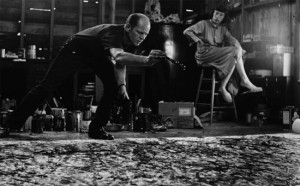



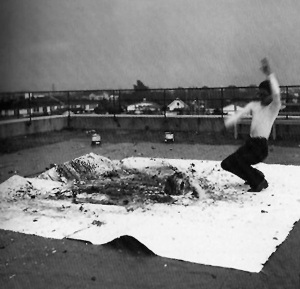












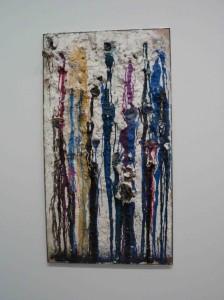









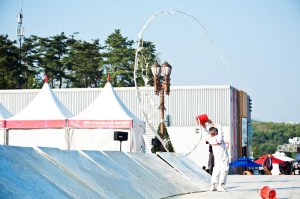
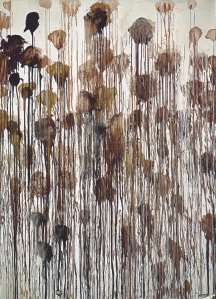

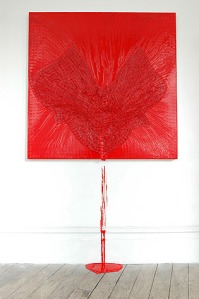















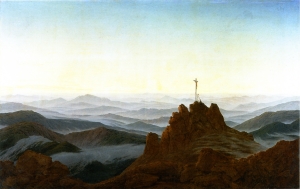






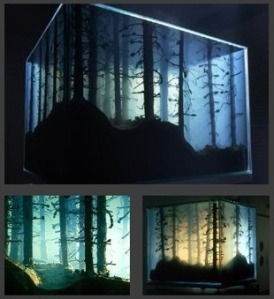
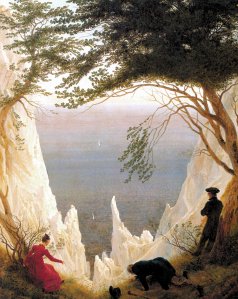



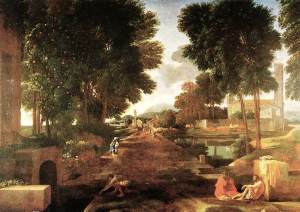
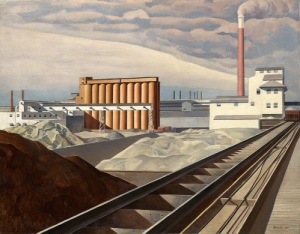





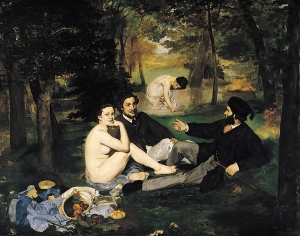

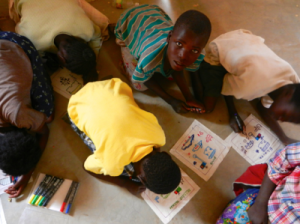



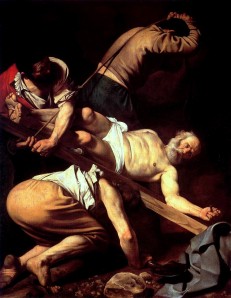


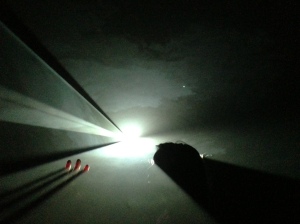
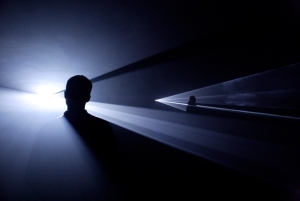








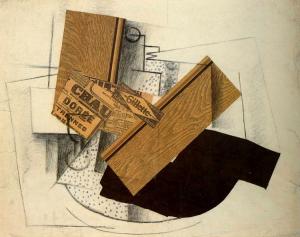




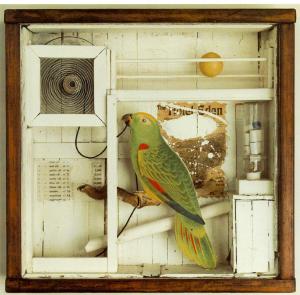



Recent Comments